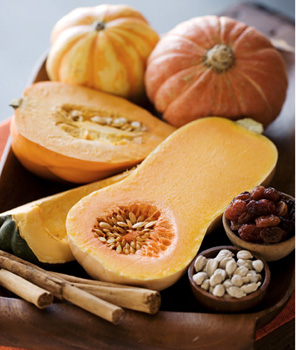 White acorn. Red Kuri. Turban. Carnival. Names as colorful as the squashes themselves. And if you’ll excuse me for saying this, sometimes they look as if they landed on earth from outer space. No offense meant towards other galactic life forces!
White acorn. Red Kuri. Turban. Carnival. Names as colorful as the squashes themselves. And if you’ll excuse me for saying this, sometimes they look as if they landed on earth from outer space. No offense meant towards other galactic life forces!
Welcome, winter squash.
A few years ago I made it a point to familiarize myself with these hefty gourds. Until that point they were only gorgeous table decorations to me (trés gay, I know I know), and also made nice ammo during food fights. Then butternuts became the popular choice and began showing up everywhere. I wasn’t complaining, I love the sweet, nutty mild flavor they bring to stews, soups and purees. But then I began to wonder about the others, and in time began to learn that even though they’re awkward, fugly, and heavy, they really are wonderful and delicious. I look forward to this time of year.
Unlike summer squashes with their soft, edible skins, winter varieties must be peeled and cooked. But it’s really easier than you think. The toughest part for me is cutting into the larger varieties like turbans and hubbards — you’ll need plenty of power (and a sharp knife!) to open those babies up. But once open, scooping out seeds and strings are easy and then it only takes some heat to get them going. Bake, boil or steam — they’re great on their own or added to other veggies and even used in place of sweet potatoes.
Perhaps my favorite thing about winter squashes is that they can walk the fine line between sweet and savory. Dress them up with a sprinkle of cheese, add them to risottos or even top with tomato sauce (as with spaghetti squash), or bake with cinnamon, butter, and honey for a sweeter, lighter flavor.
Recently I had a few boxes of squash that I needed to photograph.. Normally I’d be excited about it but have you ever tried to move around boxes and boxes of them? The suckers are heavy. But luckily they last quite a long time in the right conditions and this allowed me to spend a few afternoons in the kitchen experimenting. Adam made an amazing lamb and butternut squash stew (pictured), but it was no quick affair. I opted for faster, simpler recipes and in the process discovered one of my favorite things to do with winter squash. Try it — it’s simple and sublime.
…………………………………………………………………………………………………………………….
Winter Squash Puree with Shaved Parmesan from Amelia Saltsman’s The Santa Monica Farmer’s Market Cookbook: Seasonal Foods, Simple Recipes and Stories from the Market and Farm

Seriously people, this is easy. And the results are fantastic. And yes, consider this a plug for my friend’s book. Why? Because she is lovely, gorgeous and wonderful and cares about flavor and farmers — and she gets me excited about food!
Ingredients
1/2 cup finely chopped onion
1 large garlic clove
1 tablespoon chopped fresh sage
1 dried arbol chile, or pinch of red pepper flakes
kosher or sea salt
2 tablespoons extra virgin olive oil
2 cups roasted winter squash
about 1/2 cup vegetable or beef stock
2-4 tablespoons Parmigiano Reggiano or Winchester Sharp Gouda Cheese, plus cheese for shaving
1 tablespoon pumpkin or extra virgin olive oil
Method
In a skillet, sauté the onion, whole garlic clove, sage, chile, and a little salt in the olive oil over medium low heat until the onion is translucent and soft, 5 to 7 minutes. Stir in the squash, a little more salt, and 1/4 cup of the stock. Reduce the heat to low, cover, and cook to a thick puree, about 15 minutes, stirring frequently and adding stock as needed to keep the mixture smooth and prevent sticking. If the mixture seems too wet, uncover during the last few minutes of cooking. Remove the pan from heat, discard the chile, and mash the garlic clove into the squash. Stir in the grated cheese and salt to taste along with the pumpkin seed oil. The puree can be made a day ahead and refrigerated. Top with cheese shavings and serve at room temperature.
To roast the squash:
Matt says: Face down, squash up, that’s the way we… Oops, nevermind. But seriously folks, I’ve always been perplexed until I decided on Amelia’s method which involves roasting squash cut side down after it’s been drizzled with oilve oil and sea salt. Roast at 375°F for about 40 minutes. You’ll notice the skin will become shiny and soft and you can check by piercing with a knife. Make sure you leave at least an inch between the cut squash pieces on the baking sheet. Give them space.
-- Also published on MattBites.com


